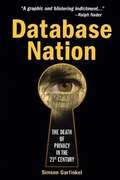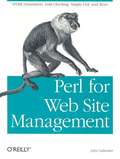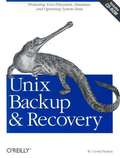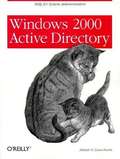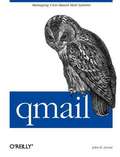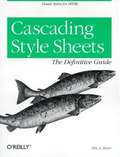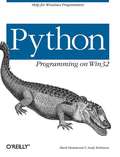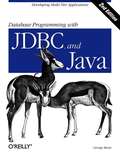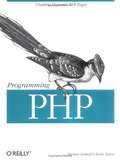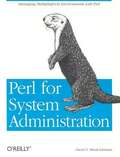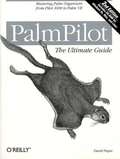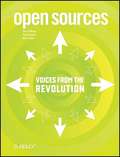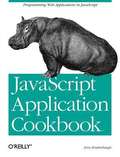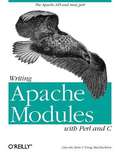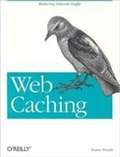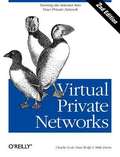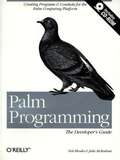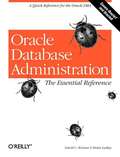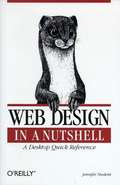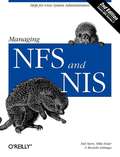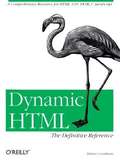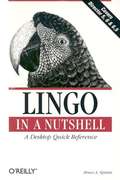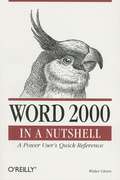- Table View
- List View
Database Nation: the Death of Privacy in the 21st Century
by Simson GarfinkelDiscusses the many ways in which individual privacy has been and is being eroded, as personal information is gathered and stored without your knowledge.
Perl for Web Site Management
by John CallenderLearn to do everyday tasks on your web site using Perl--even if you have no programming background. Perl for Web Site Managementshows how to write CGI scripts, incorporate search engines, convert multiple text files to HTML, monitor log files, and track visitors to your site. Whether you're a developer, a designer, or simply a dabbler on the Web, this is the hands-on introduction to Perl you've been waiting for.
Unix Backup and Recovery
by W. Curtis PrestonThis guide provides a complete overview of all facets of Unix backup and recovery and offers practical, affordable backup and recovery solutions for environments of all sizes and budgets. It explains everything from freely available backup systems to large-scale commercial utilities.
Windows 2000 Active Directory
by Alistair G. Lowe-NorrisThe most important change in Windows 2000 is the inclusion of Active Directory, a fully qualified directory service. It's such an important change that systems administrators are likely to find coming to grips with Active Directory to be one of their biggest headaches. But it doesn't have to be that way. Windows 2000 Active Directory puts you in charge of AD; it's an in-depth guide you will turn to whenever you need help, both before and after implementation.
qmail
by John R. Levineqmail has quietly become one of the most widely used applications on the Internet today. It's powerful enough to handle mail for systems with millions of users--Like Yahoo! Mail and Hotmail, while remaining compact and manageable enough for the smallest Unix- and Linux-based PC systems. Its component design makes it easy to extend and customize while keeping its key functions secure, so it's no wonder that adoption of qmail continues at a rapid pace. The downside? Apparently none. Except that qmail's unique design can be disorienting to those familiar with other popular MTAs (Mail Transfer Agents). If you're coming from sendmail, for instance, you might have trouble recasting your problems and solutions in qmail terms. qmail first helps you establish a "qmail frame of mind," then explores the installation, configuration, administration, and extension of this powerful MTA. Whether you're installing from scratch or managing mailing lists with thousands of users, qmail provides detailed information about how to make qmail do precisely what you want qmail concentrates on common tasks like moving a sendmail setup to qmail, or setting up a "POP toaster," a system that provides mail service to a large number of users on other computers sending and retrieving mail remotely. The book also fills crucial gaps in existing documentation, detailing exactly what the core qmail software does. Topics covered include: Installation and configuration, including patching qmail Moving from sendmail to qmail Handling locally and remotely originated messages Managing virtual domains Logging qmail activity Tuning qmail performance Running multiple copies of qmail on the same computer Mailing list setup and management Integrating the qmail MTA with POP and IMAP delivery Filtering out spam and viruses If you need to manage mailing lists, large volumes of mail, or simply find sendmail and other MTAs too complicated, qmail may be exactly what's called for. Our new guide, qmail, will provide the guidance you need to build an email infrastructure that performs well, makes sense, and is easy to maintain.
Cascading Style Sheets: The Definitive Guide
by Eric MeyerCascading Style Sheets (CSS) is poised to make its mark on the Web. With good implementations in Internet Explorer 5.0 and Opera 3.6, and 100% support expected in Netscape's "Mozilla" browser, signs are that CSS is rapidly becoming a useful, reliable, and powerful tool for web authors. CSS is the W3C-approved method for enriching the visual presentation of web pages. Cascading Style Sheets: The Definitive Guide offers a complete, detailed review of CSS1 and CSS positioning, as well as an overview of CSS2. Each property is explored in detail with a discussion of how each interacts with other properties. There is also information on how to avoid common mistakes in interpretation. This book is the first major title to cover CSS in a way that both acknowledges and describes current browser support, instead of simply describing the way things work in theory. It offers both web authors and scripters a comprehensive guide to using CSS effectively. Cascading Style Sheets: The Definitive Guide targets veteran web authors who have already invested thousands of hours in learning HTML and writing web pages and are wondering why they need to learn a brand new language of style. This book supplies those dubious but curious web authors with the information they need to easily implement CSS for their web site. This book also addresses an audience of novice web authors who are already straining to learn all of the tags and attributes of HTML and can benefit now from implementing CSS correctly instead of repeating the mistakes of the past. The author has extensive experience writing about pitfalls and interesting tricks in CSS. He is a member of the CSS and FP Working Group, coordinates the W3C's CSS1 Test Suite, remains active on CSS newsgroups, and edits Web Review's Style Sheets Reference Guide. He has built a widespread reputation as a CSS expert, particularly with regard to his understanding of the intricacies of browser support for CSS. He brings his knowledge and expertise to this book in the form of hints, workarounds, and many other tips for web authors.
Cascading Style Sheets: The Definitive Guide
by Eric MeyerCascading Style Sheets (CSS) is the HTML 4.0-approved method for controlling visual presentation on web pages. This comprehensive guide to CSS and CSS1 explores in detail each property, how individual properties interact, how to avoid common mistakes in interpretation. For both beginning and advanced web authors, this is the first major CSS title to address actual current browser support, rather than the way things work in theory.
Python Programming on Win32
by Mark Hammond Andy RobinsonDespite Python's increasing popularity on Windows, Python Programming on Win32 is the first book to demonstrate how to use it as a serious Windows development and administration tool. This book addresses all the basic technologies for common integration tasks on Windows, explaining both the Windows issues and the Python code you need to glue things together.
Database Programming with JDBC and Java, 2nd Edition
by George ReeseJava and databases make a powerful combination. Getting the two sides to work together, however, takes some effort--largely because Java deals in objects while most databases do not. This book describes the standard Java interfaces that make portable object-oriented access to relational databases possible and offers a robust model for writing applications that are easy to maintain. It introduces the JDBC and RMI packages and uses them to develop three-tier applications (applications divided into a user interface, an object-oriented logic component, and an information store). The book begins with a quick overview of SQL for developers who may be asked to handle a database for the first time. It then explains how to issue database queries and updates through SQL and JDBC. It also covers the use of stored procedures and other measures to improve efficiency, where these are available. But the book's key contribution is a set of patterns that let developers isolate critical tasks like object creation, information storage and retrieval, and the committing or aborting of transactions. The second edition includes more basics of JDBC and SQL, with more examples, and a deeper discussion about the architecture of a robust, maintainable database application. The second edition also explains the relationship between JDBC and Enterprise JavaBeans.
Database Programming with JDBC and Java, Second Edition
by George ReeseThis book describes the standard Java interfaces that make portable object-oriented access to relational databases possible, and offers a robust model for writing applications that are easy to maintain. The second edition has been completely updated for JDBC 2.0, and includes reference listings for JDBC and the most important RMI classes. The book begins with a quick overview of SQL for developers who may be asked to handle a database for the first time, and goes on to explain how to issue database queries
Programming PHP
by Rasmus Lerdorf Kevin TatroeProgramming PHPis a comprehensive guide to PHP, a simple yet powerful language for creating dynamic web content. Filled with the unique knowledge of the creator of PHP, Rasmus Lerdorf, this book is a detailed reference to the language and its applications, including such topics as form processing, sessions, databases, XML, and graphics. Covers PHP 4, the latest version of the language.
Perl for System Administration
by David N. Blank-EdelmanPerl for System Administrationis for anyone who needs to use Perl for administrative tasks and needs to hit the ground running.
PalmPilot: The Ultimate Guide, 2nd Edition
by David PogueThis new edition of O'Reilly's runaway bestseller is densely packed with previously undocumented information. The bible for users of Palm VII and all other Palm models, it delivers hundreds of timesaving tips and surprising tricks, plus an all-new CD-ROM (for Windows 9x, NT, or Macintosh) containing over 3,100 PalmPilot programs from the collection of palmcentral.com, the Internet's largest Palm software site.
Open Sources: Voices from the Open Source Revolution
by Chris Dibona Mark Stone Sam Ockman Open Source Organization Brian Behlendorf Scott Bradner Jim Hamerly Kirk Mckusick Tim O'Reilly Tom Paquin Bruce Perens Eric S. Raymond Richard Stallman Michael Tiemann Linus Torvalds Paul Vixie Larry Wall Bob YoungThrough essays that explain how the movement works, why it succeeds, and where it is going. A powerful vision from the movement's spiritual leaders, this book reveals the mysteries of how open development builds better software and how businesses can leverage freely available software for a competitive business advantage.
JavaScript Application Cookbook
by Jerry BradenbaughThere is a serious information gap for Webmasters learning client-side JavaScript skills and trying to solve common Web-related problems. Knowing the syntax is one thing, being able to build a useful application is another. And while there are dozens of "how- to" JavaScript books available, few literally hand the Webmaster a set of ready-to-go, client-side JavaScript applications with thorough documentation that enable the reader to fully understand and extend those applications. By providing such a set of applications, JavaScript Application Cookbook allows Webmasters to immediately add extra functionality to their Web sites. This book targets readers with two different skill sets. The primary target is JavaScript-knowledgeable Webmasters and designers who can immediately begin constructing their own versions of the applications. The secondary target is those with little or no JavaScript experience. The included applications are ready for immediate use and require little customization. This book explores both the code and the techniques that are centered around core JavaScript functionality, a functionality that will not become incompatible or obsolete. The source file design of most applications and libraries will help modularize reader Web sites and facilitate easier site management and coding practices. Chapters are organized by application. Among the included applications are: A client-side search engine that will show coders how to build their own search engine and get excellent results, all with a client-side tool A drag-and-drop greeting application that lets users custom build and send DHTML email greetings A GUI image rollover tool that generates cross-browser image rollover code for all versions of JavaScript A robust client-side shopping cart application that lets shoppers browse and shop, while the application keeps a tab of the shopper's selections and a running bill, including tax and shipping An online test application that auto-administers, grades, and displays answers to online exams or surveys An additional value to this book is an online resource (http://www.serve.com/hotsyte/) that discusses the applications and points to other resources. With its focus on providing practical real-world solutions for Webmasters, JavaScript Application Cookbook is destined to become a staple for every JavaScript developer, regardless of experience.
Writing Apache Modules with Perl and C
by Doug Maceachern Lincoln SteinThis guide to web programming shows how to extend the capabilities of the Apache web server. It explains the design of Apache, mod_perl, and the Apache API, then demonstrates how to use them to rewrite CGI scripts, filter HTML documents on the server-side, enhance server log functionality, convert file formats on the fly, and more.
Web Caching
by Duane WesselsA properly designed web cache, by reducing network traffic and improving access times to popular web sites, is a boon to network administrators and web users alike. This book hands you all the technical information you need to design, deploy, and operate an effective web caching service. It also covers the important political aspects of web caching, including privacy and security issues.
Virtual Private Networks, Second Edition
by Mike Erwin Charlie Scott Paul WolfeThis book explains how to plan and build a Virtual Private Network (VPN), a collection of technologies that creates secure connections or "tunnels" over regular Internet lines. It discusses costs, configuration, and how to install and use VPN technologies that are available for Windows NT and Unix, such as PPTP and L2TP, Altavista Tunnel, Cisco PIX, and the secure shell (SSH). New features in the second edition include SSH and an expanded description of the IPSec standard.
Palm Programming: The Developer's Guide
by Neil Rhodes Julie MckeehanPalmPilot's popularity is growing and with over a million units sold, the Palm OS dominates the hand-held market. Wired has astutely described Palm's position in a recent article: "On its way to becoming the bestselling hand-held computer of all time, the 3Com PalmPilot has spawned an intense, emotional, and fanatical developer following not seen since the glory days of the Mac." (Wired, 20 Feb. 98). Palm Programming should be eagerly accepted by programmers because the authors worked closely with Palm to ensure that the book is tailored exactly to the needs of the ever-growing group of Palm developers. As nothing but some piecemeal documentation exists currently, this book provides a much needed solution to the Palm developers. In fact, Palm uses this book as their official developer's guide and will be using it in the future as a key part of their training materials for developers. There are currently no books on Palm programming (and we know of none that are planned). The only way to learn is by using the reference material published by Palm (available freely on their Web site), the tutorial they provide, or various Palm programming FAQs compiled by third parties. Palm Programming shows intermediate to experienced C programmers how to build a Palm application from the ground up. Using an easy-to- understand tutorial approach, this book gives readers everything necessary to create a wide range of Palm applications and conduits, from simple scripts through full-blown applications, and in the process provides thorough coverage of Palm programming. It includes a CD-ROM (Macintosh and Windows compatible) with the full source code to the examples in the book, a trial version of Palm's Software Development Kit, and third-party developer tools, including Metrowerks' CodeWarrior Lite programming kit. Outline Part 1: Overview of Palm OS and devices Chapter 1: The Palm Solution Chapter 2: Developing for Palm OS Chapter 3: Designing a solution Part 2: Programming for the handheld Chapter 4: Structure of an Application Chapter 5: Forms and Form Objects Chapter 6: Databases Chapter 7: Menus Chapter 8: Extras Chapter 9: Communications Chapter 10: Debugging Part 3: Programming for the desktop: conduits Chapter 11: Getting started with conduits Chapter 12: Uploading and Downloading Data Chapter 13: Two-way Syncing Appendix: Where to go from here
Oracle Database Administration, The Essential Reference
by David C. Kreines Brian LaskeyA concise reference to the enormous store of information Oracle8 or Oracle7 DBAs need every day, Oracle Database Administrationcovers DBA tasks like installation, tuning, backups, networking, auditing, and query optimization. It's also a set of quick references on initialization parameters, SQL statements, data dictionary tables, system privileges, roles, and syntax for SQL*Plus, Export, Import, and SQL*Loader.
Web Design in a Nutshell
by Jennifer Niederst RobbinsWeb Design in a Nutshell contains the nitty-gritty on everything you need to know to design Web pages. It's the good stuff, without the fluff, written and organized so that answers can be found quickly. Written by veteran Web designer Jennifer Niederst, this book provides quick access to the wide range of front-end technologies and techniques from which Web designers and authors must draw. It is an excellent reference for HTML 4.0 tags (including tables, frames, and Cascading Style Sheets) with special attention given to browser support and platform idiosyncrasies. The HTML section is more than a reference work, though. It details strange behavior in tables, for instance, and gives ideas and workarounds for using tables and frames on your site. Web Design in a Nutshell also covers multimedia and interactivity, audio and video, and emerging technologies like Dynamic HTML, XML, embedded fonts, and internationalization. The book includes: Discussions of the Web environment, monitors, and browsers A complete reference to HTML and Server Side Includes, including browser support for every tag and attribute Chapters on creating GIF, JPEG and PNG graphics, including designing with the Web Palette Information on multimedia and interactivity, including audio, video, Flash, Shockwave, and JavaScript Detailed tutorial and reference on Cascading Style Sheets, including an appendix of browser compatibility information Appendices detailing HTML tags, attributes, deprecated tags, proprietary tags, and CSS compatibility
Managing NFS and NIS, 2nd Edition
by Mike Eisler Ricardo Labiaga Hal SternThis long-awaited new edition of a classic, now updated for NFS Version 3 and based on Solaris 8, shows how to set up and manage a network filesystem installation. Managing NFS and NIS is the only practical book devoted entirely to NFS and the distributed database NIS; it's a "must-have" for anyone interested in Unix networking.
Dynamic HTML: The Definitive Reference
by Danny GoodmanIf you are a Web content developer these days, you have a lot of information to keep track of. You need to stay current on the relevant Web specifications, like HTML, CSS, DOM, and ECMAScript. You also need to know how the latest Web browsers from Netscape and Microsoft actually implement these standards, since browser implementations of the standards are less than perfect. Right now, you're forced to keep multiple reference books open on your desk (or multiple browser windows open on your screen), just to develop a simple dynamic Web page that works properly under both Navigator and Internet Explorer. Dynamic HTML: The Definitive Reference changes all that. This book is an indispensable compendium for Web content developers. It contains everything you need to create functional cross-platform Web applications, including: A complete reference for all of the HTML tags, CSS style attributes, browser document objects, and JavaScript objects supported by the various standards and the latest versions of Navigator and Internet Explorer. Browser compatibility is emphasized throughout; the reference pages clearly indicate browser support for every entity. Handy cross-reference indexes that make it easy to find interrelated HTML tags, style attributes, and document objects. An advanced introduction to creating dynamic Web content that addresses the cross-platform compromises inherent in Web page design today. If you have some experience with basic Web page creation, but are new to the world of dynamic content, Dynamic HTML: The Definitive Reference will jump-start your development efforts. If you are an experienced Web programmer, you'll find the browser-compatibility information invaluable. This book is the only DHTML reference that a Web developer needs. Dynamic HTML: The Definitive Reference is designed to work in conjunction with HTML: The Definitive Guide and JavaScript: The Definitive Guide . HTML: The Definitive Guide teaches you about every element of HTML in detail, with explanations of how each element works and how it interacts with other elements, as well as numerous examples. JavaScript: The Definitive Guide provides a thorough description of the JavaScript language, complete with sophisticated examples that show you how to handle common Web application tasks. Together, these three books provide a complete library for Web content developers.
Lingo in a Nutshell
by Bruce A. EpsteinMacromedia Director 6 is the premiere authoring tool for delivering interactive content on both the Internet and the desktop. It is the dominant multimedia package for Windows 95/NT, Windows 3.1, and the Macintosh. A quarter million developers use Director(R) to incorporate animation and audio into dynamic Web pages, and to create engaging interactive corporate presentations, multimedia advertising, entertainment CD-ROMs, Enhanced music CDs, and even DVDs. Lingo is Director's powerful scripting language. This companion book to Director in a Nutshell is an essential tool for both new and experienced Lingo programmers seeking a deeper knowledge of the language. Bruce Epstein is the author of both these books and brings years of hands-on experience with Director and Lingo. The book includes numerous useful Lingo examples. Exhaustively tested, this book corrects many errors found in Macromedia's Lingo documentation and repeated verbatim in most third-party books. Extremely comprehensive, this book details dozens of misdocumented and undocumented Lingo keywords that are omitted from Macromedia's manuals and third-party books. Lingo in a Nutshell caters to the huge pool of Director users attempting to bridge the Lingo gap, yet provides the details for the experienced Linguist that are lacking in other Lingo books. In typical nutshell style (clear, concise, deep and narrow) this book explores the syntax, structure and commands of the Lingo language. The detailed chapters describe messages, events, scripts, handlers, variables, lists, file I/O, Behaviors, child objects, Xtras, and more. This book teaches you to troubleshoot and debug common Lingo errors. Lingo in a Nutshell is the book for which both Director users and power Lingo programmers have been yearning. The book extensively covers topics not found in other Lingo books: Cross-platform Lingo differences Lingo internals for experienced programmers Events, messages, and scripts Timers, tempos, cue points, and synchronization Data types and expressions Math, numerical expressions, geometry, and trigonometry Coordinates, alignment, and registration point Lingo in a Nutshell is the most concise and compete guide available. It is a high-end handbook at a low-end price. An essential desktop reference for every Director user.
Word 2000 in a Nutshell
by Walter GlennWord 2000 in a Nutshellis a clear, concise, and complete reference to the most popular word-processing program in the world. This book is the first choice of the Word power user who needs help completing a specific task or understanding a command or topic. It's also an invaluable resource that uncovers Word 2000's undocumented features and shares powerful time-saving tips.
